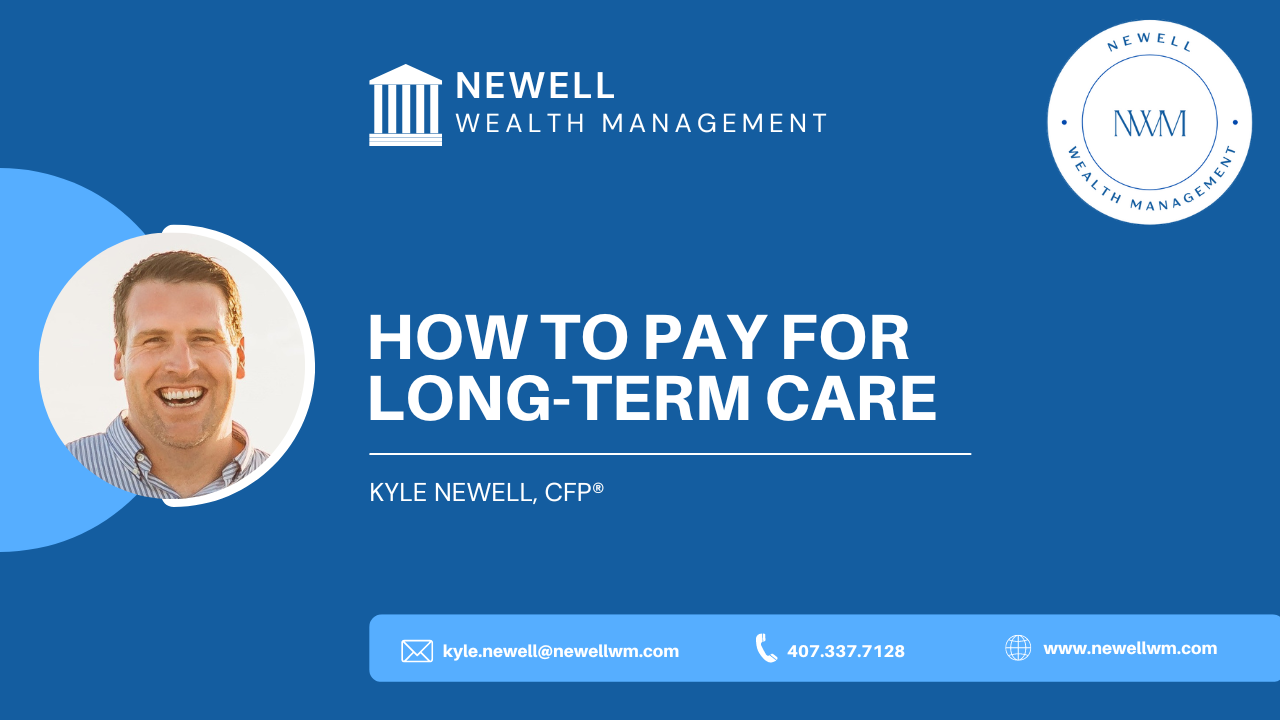How to Pay for Long-term Care

Aging is a part of life. It’s a topic that many don’t want to think about or consider until they are older or closer to getting a lot older. It may not be a comfortable topic, but it’s something that I think everyone should think about when making their financial plans, as the cost can be substantial. How to pay for long-term care can seem overwhelming but there are options.
I like to think about retirement as having three phases. When I talk about aging and long-term care, I’m referring to the last phase of retirement.
1) The young and fun phase
You might retire early, maybe in your 50s or early 60s. In this phase, you’re typically young and healthy enough to travel, visit family, volunteer, etc. This is the phase that most people think about when they retire. It’s sometimes the only phase they even consider.
2) The slowdown phase
You’re a little older, still healthy, and don’t need much help. In this phase, you may not be traveling as much but can still do everyday activities and things around the house. Things are still good, and you are reasonably independent.
3) The final phase
This is the phase where you can no longer do things for yourself. Some people may get help from nurses or move into an assisted living facility or something of that nature. The final phase can be one of the most expensive because it can cost a substantial amount to have professional help.
If you need professional help, such as healthcare, 24-hours/7 days per week, you could pay $50,000 to $100,000 or more a year just for the care. This doesn’t include your regular expenses like food, utilities, etc.
Many people say, “If I get to that point, just unplug me.” While I can certainly understand the premise, it doesn’t usually work out that way. Often, it’s a slow fade to this phase. Once you’re there, it’s often your family’s decision and not yours. Often, families want to make sure everybody’s as healthy and happy as they can be.

Knowing this, the question now becomes, “how do I pay for long-term care?” There are a few options available to you. Some are more desirable than others.
Self-Pay
Your first option is self-pay. Basically, you pay the money out-of-pocket yourself for whatever care you need. Hopefully, you have saved enough throughout your lifetime to have enough money to pay the extra costs, whatever they may be. They can be substantial, so that’s where you can use your IRA, 401k, mutual funds, stocks, or other savings.
It’s a good option if you can afford to do so. Many people can use this option, especially if you’re a Disney cast member. Many cast members retiring more recently from Disney have pensions to help with these retirement costs.
Consider saving extra to pay for that self-care if you are younger. Using things like a health savings account may be a good idea.
Insurance
The second option is using some insurance-type product to pay for long-term care needs. These insurances fall into different categories.
1) Long-term care insurance
This type of insurance is just traditional insurance, which means you pay an annual or monthly premium for a certain amount of benefits. The benefit usually lasts for a specific amount of time. Sometimes older policies last a lifetime, but not all policies do that—many of them last maybe two or three years.
In essence, you pay the premium, and should something happen; coverage is there. You will be covered for however much coverage you purchased, $100,000, for example. There are a bunch of different bells and whistles you can add, which will raise the price of your premium but may give you peace of mind.
2) Hybrid approach
Tying a whole life or universal life insurance with a long-term care product is the basis of the hybrid approach. Life insurance providers started getting into the long-term care business because the numbers are based on a 100% probability that people will die.
Historically, many of the original long-term care insurers got in trouble because their math, numbers, and actuary tables didn’t quite work out. Many of these companies have stepped away from long-term care insurance. This has opened the door for life insurance companies to step in.
The new era has options where you can either pay a lump sum upfront or make annual payments for ten years or even your lifetime. The advantage of hybrid policies is that some of the cash value is available to use. If you need it, you can pull that cash value out. If you don’t end up using long-term care insurance, your beneficiaries still get a death benefit. It’s usually a reduced death benefit, but nonetheless, there’s still a death benefit.
Compare that to the traditional insurance model where you pay the insurance, and if you never use it, it just goes away. The insurance company has taken all the money, and you or your family have nothing to show for it. The traditional model isn’t wrong because it protects you against risk. All insurance, home, car, etc., exists to protect us against a risk though we hope we never have to use it.
Ultimately, the hybrid model gives you more options than just paying for long-term care because it is also tied to a life insurance policy.
3) Annuity with long-term care rider
The third option may be less familiar to you. Annuities are issued by insurance companies. They usually will give some guarantee like income or growth. In the case of long-term riders, it gives you some guarantees around long-term care insurance. If you require long-term care, then you may be able to get some additional monies above what you put into the contract.
Now, annuities have a bad rap, in many instances, possibly rightfully so. There are a lot of extras and moving parts. They are very complicated contracts that you want to understand before signing up for any of those options. Still, it’s an option if you think it’s a risk that might happen. You can offload the risk and pay the bulk of it to somebody else, like an insurance company, rather than taking the onus on yourself.
The reality is that there are high odds of having some aging long-term care event. I’ve seen statistics that once you’re over 65, one in two or three people will have some long-term care need. The degree and amount of time can vary, but the event itself is highly likely. The insurance is nice because you can offload the risk to the insurance company.
The downside, of course, is that it will come with some cost. There is some necessary consideration to evaluate the cost to see if it’s worth the trade-off.
4) Medicare
While this is an option, it’s important to note that Medicare only pays for up to about 100 days of long-term care. This is because Medicare is a type of traditional insurance offered by the government. Medicare is designed primarily to get people healthy.
When you are in a long-term care event, there’s no real prospect of returning to total health again. You need care on an ongoing basis for things like getting dressed, going to the restroom, bathing, etc. When Medicare coverage stops, if you still need care, you must go to one of the first three options or consider the final option, Medicaid.
5) Medicaid
Medicaid is not available to everyone. It’s an insurance program for the poor and destitute. You must have less than $2,000 of assets in Florida to qualify. Different states have different rules, so you need to check the parameters of your state. In short, you need to have very few assets and income. If you qualify, the state will pick up the cost of your care.
Usually, they take all your income sources, like Social Security and pension. Whatever the difference is, they’ll pay on top of that. Medicaid will come in, but you have to basically lose all of your assets or get rid of all of your assets before that time. There are a couple of caveats. You can keep your house, car, and about $2,000 to your name. Anything above that would have to be used to pay for long-term care until you no longer have the money, and then Medicaid would begin.
Start planning now
As you can see, there are many different options to pay for aging care. It’s good to understand and think about it while you’re young enough to be able to do something about it. You don’t want to be thinking about this when you are closer to the event.
Plan and save for it. Saving a little bit over a long time ends up being a good amount of money that you can save or put away to cover those costs.
Long-term care is generally needed when you cannot do daily living activities. Think about the first 30 minutes of your day. If you need help with things like:
- Getting out of bed
- Getting dressed
- Taking a shower
- Going to the restroom
- Cooking
Typically you must require help with two of the above to qualify for long-term care unless you have a cognitive disease like dementia or Alzheimer’s.
There’s a lot to consider toward the end of life and aging. These are just some ways to pay for that phase of life. Many other things should be planned, including:
- What type of care you want
- Who will provide that care
- Who’s responsible for coordinating your care
- The list goes on…
If you haven’t considered the aging phase and the possibility of long-term care in your retirement plans, I’m here to help.
Important Information
Newell Wealth Management, LLC (“NWM”) is a registered investment advisor offering advisory services in the State of FL and in other jurisdictions where exempted. Registration does not imply a certain level of skill or training. The presence of this website on the Internet shall not be directly or indirectly interpreted as a solicitation of investment advisory services to persons of another jurisdiction unless otherwise permitted by statute. Follow-up or individualized responses to consumers in a particular state by NWM in the rendering of personalized investment advice for compensation shall not be made without our first complying with jurisdiction requirements or pursuant an applicable state exemption.
All written content on this site is for information purposes only and is not intended to provide specific advice or recommendations for any individual. Opinions expressed herein are solely those of NWM, unless otherwise specifically cited. Kyle Newell and NWM are neither an attorney nor an accountant, and no portion of this website content should be interpreted as legal, accounting or tax advice. Material presented is believed to be from reliable sources and no representations are made by our firm as to other parties’ informational accuracy or completeness. There is no assurance that the views or strategies discussed are suitable for all investors or will yield positive outcomes. Investment involves risks including possible loss of principal and unless otherwise stated, are not guaranteed. Any economic forecasts set forth may not develop as predicted and are subject to change. All information or ideas provided should be discussed in detail with an advisor, accountant or legal counsel prior to implementation.
